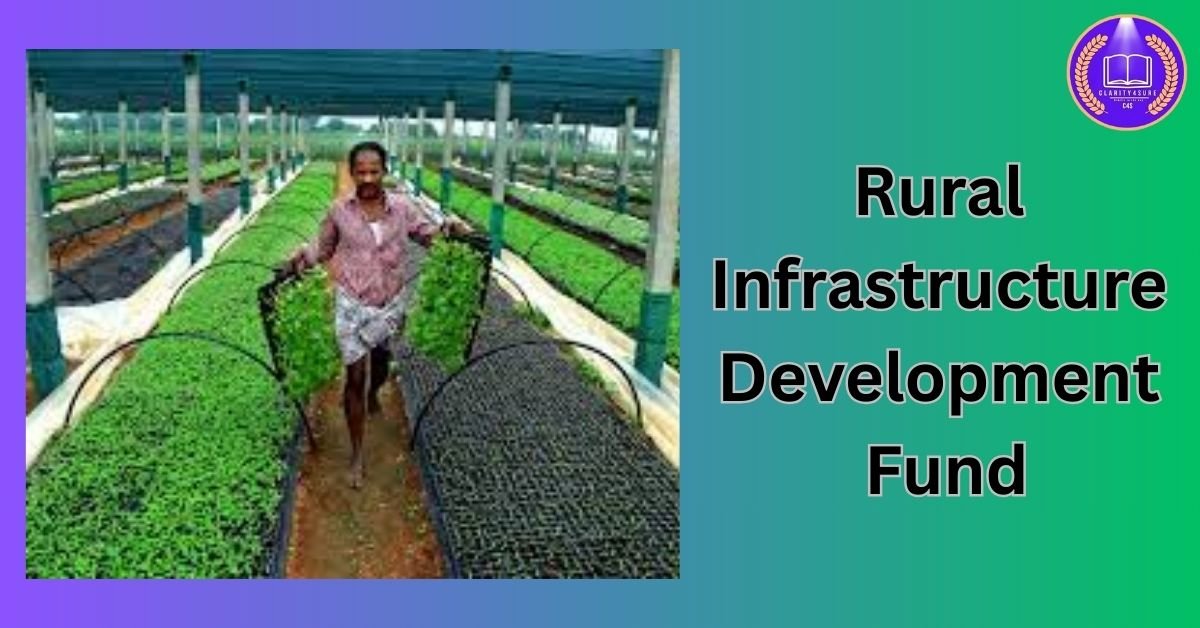Introduction
Rural development is a key pillar of economic growth, and robust infrastructure plays a vital role in uplifting rural communities. In many developing countries, including India, rural areas still lack adequate roads, irrigation facilities, healthcare centers, schools, and electricity, affecting millions of people. To address this challenge, the Rural Infrastructure Development Fund (RIDF) was established to provide financial support for rural infrastructure projects, enhancing agricultural productivity, connectivity, and overall living standards.

Introduction
Rural infrastructure is the foundation of a strong rural economy. It connects villages to cities, enables farmers to access markets, improves education and healthcare, and promotes industrial growth in rural regions. However, rural areas often face infrastructure deficits, including:
- Poor road connectivity, making it difficult for farmers to transport their produce.
- Limited irrigation facilities, leading to dependency on unpredictable rainfall.
- Inadequate healthcare and education, affecting rural livelihoods.
- Lack of electricity and digital connectivity, hindering technological advancements.
To overcome these challenges, the Government of India, through NABARD (National Bank for Agriculture and Rural Development), established the Rural Infrastructure Development Fund (RIDF) in 1995-96. Since then, RIDF has been instrumental in strengthening rural economies by financing various projects that improve agriculture, education, healthcare, irrigation, and rural connectivity.
What is the Rural Infrastructure Development Fund (RIDF)?
The Rural Infrastructure Development Fund (RIDF) is a long-term financing mechanism managed by NABARD. It provides low-cost loans to state governments, rural local bodies, and other agencies to develop essential infrastructure in rural areas.
Initially, RIDF focused on agriculture and irrigation projects, but over the years, its scope has expanded to include over 30 sectors, covering rural roads, healthcare, education, drinking water, sanitation, renewable energy, and rural industrial development.
Key Features of RIDF:
- Launched: 1995-96
- Managed by: NABARD
- Objective:
- Financing rural infrastructure projects
- Beneficiaries:
- State governments, rural local bodies, panchayats, cooperative institutions
- Sectors Covered:
- Irrigation, rural roads, bridges, healthcare, education, markets, renewable energy, and more
- Funding Mechanism:
- Loans provided at concessional interest rates
Objectives of the Rural Infrastructure Development Fund (RIDF)
RIDF was created with the primary objective of strengthening rural infrastructure to improve the quality of life and boost economic development. The major objectives of RIDF include:
Bridging the Rural Infrastructure Gap
- Financing projects that address critical gaps in rural connectivity, healthcare, irrigation, and education.
- Ensuring that villages have access to basic amenities for a better quality of life.
Enhancing Agricultural Productivity
- Supporting irrigation projects, watershed development, and water conservation initiatives.
- Encouraging the use of modern agricultural techniques through better infrastructure.
Promoting Rural Employment and Economic Growth
- Creating direct and indirect employment opportunities through infrastructure projects.
- Strengthening rural industries, storage, and cold chain logistics to boost economic activity.
Improving Rural Connectivity
- Constructing and upgrading rural roads and bridges for seamless transportation.
- Enhancing market linkages for farmers to get better prices for their produce.
Ensuring Sustainable Development
- Promoting renewable energy solutions like solar and wind power in rural areas.
- Developing climate-resilient infrastructure to mitigate the impact of climate change.
Key Sectors Covered Under RIDF
Over the years, RIDF has evolved to cover a wide range of rural infrastructure projects. Some of the key areas include:
Irrigation and Water Resources
- Building irrigation canals, check dams, and reservoirs
- Implementing rainwater harvesting and watershed development
- Enhancing sustainable water management for agriculture
Rural Roads and Bridges
- Developing rural roads for better accessibility
- Constructing bridges to improve connectivity to remote villages
- Linking farmers to markets to ensure better price realization
Agricultural and Rural Market Infrastructure
- Setting up cold storage and warehouses for agricultural produce
- Building rural market yards and logistics hubs
- Promoting dairy, poultry, and fishery infrastructure
Health and Education
- Constructing primary health centers and hospitals in rural areas
- Building rural schools, colleges, and skill training institutes
- Ensuring better medical and educational facilities in villages
Drinking Water and Sanitation
- Implementing rural drinking water supply schemes
- Developing sanitation facilities and solid waste management
- Promoting hygiene awareness in rural communities
Renewable Energy and Sustainable Initiatives
- Installing solar panels and wind turbines for rural electrification
- Encouraging biogas plants and energy-efficient technologies
- Developing green projects for sustainable growth
Benefits and Impact of RIDF
RIDF has played a transformative role in rural India, benefiting millions of people by improving infrastructure, employment opportunities, and economic growth.
- Increased Agricultural Productivity –
- Irrigation projects have helped farmers increase crop yield.
- Better Connectivity –
- Rural roads and bridges have improved transportation and market access.
- Enhanced Healthcare & Education –
- More hospitals and schools have led to improved literacy and healthcare services.
- Employment Generation –
- Infrastructure projects have created thousands of jobs in rural areas.
- Improved Living Standards –
- Access to clean drinking water, sanitation, and electricity has enhanced the quality of life in villages.
- Sustainable Development –
- Solar and wind power projects have reduced dependency on fossil fuels.
Challenges in Implementing RIDF Projects
Despite its success, RIDF faces several challenges in execution:
- Delays in project approvals and implementation
- Lack of awareness among rural communities about funding opportunities
- Limited participation from private sector and local stakeholders
- Geographical and climatic barriers affecting infrastructure projects
- Insufficient financial allocations for large-scale projects
To overcome these challenges, stronger policy support, efficient fund utilization, and better coordination between government agencies and local authorities are needed.
Future of Rural Infrastructure Development Fund (RIDF)
As India moves towards digital and sustainable development, RIDF will play a crucial role in shaping the future of rural areas. Some key focus areas for the future include:
- Smart Villages and Digital Connectivity –
- Expanding internet access in rural areas.
- Public-Private Partnerships (PPP) –
- Encouraging private investments in rural infrastructure.
- Climate-Resilient Infrastructure –
- Developing disaster-proof infrastructure.
- Increased Funding & Policy Reforms –
- Strengthening budget allocations and easing bureaucratic delays.
With the right policies and efficient execution, RIDF will continue to be a game changer in rural development.
Conclusion
The Rural Infrastructure Development Fund (RIDF) is not just a funding mechanism—it is a catalyst for rural transformation. From better roads and irrigation to healthcare, education, and renewable energy, RIDF has significantly contributed to rural India’s progress.
To achieve a truly self-reliant and prosperous rural economy, we must continue to invest in infrastructure, empower rural communities, and ensure sustainable development.




















